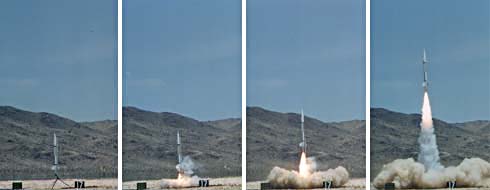| Manufacturer: | Dynacom |
Dynacom kits are legendary for their strength and high level of design. These all-fiberglass and metal kits are the pinnacle of kit-built rocketry. Unfortunately, by the time I was ready to try them in the summary of 1998, Dynacom had temporarily stopped taking orders due to family medical problems. But by the end of the year, they had resumed business and I ordered two kits the Python and the Bull Pup.
The Bull Pup missile is a very popular subject and is often kitted and scratchbuilt. You can see that the Dynacom 5" Bull Pup kit comes closes to the AGM-12B missile and I painted it so. Unfortunately, I was in a hurry to get it ready for the June '99 ROC-stock so I didn't do too elaborate a job.
The Pictures
This rocket was finished just under the wire for ROC-stock (June 11-13, 1999). In fact, I didn't have time to take pictures of the completed rocket before leaving for ROC-stock, so the picture below was taken at my camp.
The first flight of the Bull Pup was on an L850. I wanted to use my 76mm
motor casing and the L850 was the largest one for which the rocket was clearly
stable.

The rocket zoomed right up with an impressive roar, but arced over as it flew and ended up toward the west side of the range at apogee. We saw the parachute, and I thought I knew where it came down, but we never did manage to recover the rocket. The perimeter of Lucerne Dry Lake is covered with sage and my rocket is probably resting comfortably behind one of the innumerable sage bushes.
The Kit
Of course, I had to wait several months to get it (good thing I had other projects in the works), but these rockets are definitely with the wait. There are no wood or plastic parts in the kit; just fiberglass and aircraft aluminum. The instructions are simple and straight-forward and kit construction should present no problems to the experienced high power kit builder.All body parts are made out of wound G-10 fiberglass the the fins are G-10 sheet. The edges of the fins come pre-beveled and every part is precision fit. In a way, this kit builds too easily. I built up the airframe in only about 3 hours elapsed, which was a little too quick. The kit didn't even come with instructions, but after building the Python, it wasn't difficult to figure out.
The kit comes with no recovery system at all. There wasn't even a provision for an electronics bay. I ended up letting a 38mm tube into the nose cone to act as the bay so I could use an ALTS20 altimeter. I chose a Rocketman R9C as the parachute since the dry weight ended up at 12.55lbs.
Sponsored Ads
 |
 |











